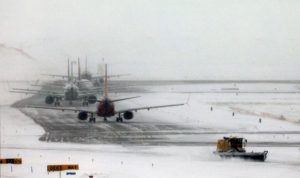
By Alex Dobuzinskis and Rich McKay
(Reuters) – Thousands of Arkansas, Oklahoma and Louisiana residents braced for more flooding on Thursday as swollen rivers continued to rise, although the threat of rain was expected to ease by the afternoon, officials said.
Many in the U.S. Southern states have already evacuated homes, as of further flooding drove fears that decades-old levees girding the Arkansas River may not hold.
There were no reports of major levee breaks early on Thursday, said Dylan Cooper, a meteorologist with the National Weather Service’s office in Little Rock, Arkansas.
“The rivers and tributaries are still rising from all that water flowing downstream from up north,” said Cooper.
“We call it the bathtub effect. There’s only so much water that the levees and reservoirs can hold before that water just spills over,” he said.
The only good news is that it looks like the area is going to have a dry few days into the weekend, said Bob Oravec, a meteorologist with the NWS Weather Prediction Center in College Park, Maryland.
“They can use any dry weather they can get,” said Oravec.
More than a week of violent weather, including downpours and deadly tornadoes, has lashed the central United States, bringing record-breaking floods in parts of the states, turning highways into lakes and submerging all but the roofs of some homes.
Arkansas Governor Asa Hutchinson told a news conference on Wednesday, that the state is experiencing a “flood of historic magnitude.”
Flooding has already closed 12 state highways, he said, and 400 households have agreed to voluntary evacuations.
Hutchinson sent a letter to U.S. President Donald Trump on Wednesday asking for a federal emergency declaration for Arkansas.
The levee system along the Arkansas River “has not seen this type of record flooding” before, Hutchinson said in his six-page letter.
Hutchinson said Trump had promised assistance in an earlier conversation, several media outlets reported.
Rivers were expected to crest by early June to the highest levels on record all the way down to Little Rock, Arkansas, forecasters said.
“We’ve had river highs of 44.9 feet in places,” said Cooper of the Arkansas River. “We’re blowing through records.”
In Tulsa, Oklahoma’s second largest city, Mayor G.T. Bynum warned that the city’s levees were being tested “in a way that they have never been before.”
He said the 20-mile (32 km) levee system, which protects some 10,000 people, was working as designed so far and being patrolled around the clock by the Oklahoma National Guard.
At least six people have died in the latest round of flooding and storms in Oklahoma, according to the state’s Department of Health.
More than 300 tornadoes have touched down in the Midwest in the past two weeks. Tornadoes pulverized buildings in western Ohio on Monday, killing one person and injuring scores.
In Louisiana, the Mississippi River was also at record flood levels due to record-breaking rainfalls this spring, forecasters said.
Trump authorized emergency aid from the Federal Emergency Management Agency for the state late on Wednesday.
In Baton Rouge, Louisiana, the Mississippi rose above flood stage in early January and has remained there since, forecasters said.
(Reporting by Alex Dobuzinskis in Los Angeles, Rich McKay in Atlanta, and Jonathan Allen in New York; Editing by Raissa Kasolowsky)








![A police car is submerged in New Orleans East August 31, 2005 after Hurricane Katrina hit the area. Authorities struggled on Wednesday to evacuate thousands of people from hurricane-battered New Orleans as food and water grew scarce and looters raided stores, [while U.S. President George W. Bush said it would take years to recover from the devastation.]](https://d2c13moo8u717n.cloudfront.net/wp-content/uploads/sites/11/2019/11/13130327/2019-11-13T161034Z_1_LYNXMPEFAC1SG_RTROPTP_4_USA.jpg)






